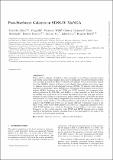Files in this item
Post-starburst galaxies in SDSS-IV MaNGA
Item metadata
| dc.contributor.author | Chen, Yan-Mei | |
| dc.contributor.author | Shi, Yong | |
| dc.contributor.author | Wild, Vivienne | |
| dc.contributor.author | Tremonti, Christy | |
| dc.contributor.author | Rowlands, Kate | |
| dc.contributor.author | Bizyaev, Dmitry | |
| dc.contributor.author | Yan, Renbin | |
| dc.contributor.author | Lin, Lihwai | |
| dc.contributor.author | Riffel, Rogério | |
| dc.date.accessioned | 2019-09-09T15:30:03Z | |
| dc.date.available | 2019-09-09T15:30:03Z | |
| dc.date.issued | 2019-11 | |
| dc.identifier | 261094407 | |
| dc.identifier | fccb1fd5-f239-4af9-a58b-63fad2b567e8 | |
| dc.identifier | 85075243391 | |
| dc.identifier | 000489302400091 | |
| dc.identifier.citation | Chen , Y-M , Shi , Y , Wild , V , Tremonti , C , Rowlands , K , Bizyaev , D , Yan , R , Lin , L & Riffel , R 2019 , ' Post-starburst galaxies in SDSS-IV MaNGA ' , Monthly Notices of the Royal Astronomical Society , vol. 489 , no. 4 , pp. 5709–5722 . https://doi.org/10.1093/mnras/stz2494 | en |
| dc.identifier.issn | 0035-8711 | |
| dc.identifier.other | BibCode: 2019arXiv190901658C | |
| dc.identifier.uri | https://hdl.handle.net/10023/18442 | |
| dc.description | Funding: European Research Council via the award of a starting grant (SEDMorph; P.I. V. Wild) (VW, KR). | en |
| dc.description.abstract | Post-starburst galaxies, identified by their unusually strong Balmer absorption lines and weaker than average emission lines, have traditionally been selected based on their central stellar populations. Here we identify 360 galaxies with post-starburst regions from the MaNGA integral field survey and classify these galaxies into three types: 31 galaxies with central post-starburst regions (CPSB), 37 galaxies with off-center ring-like post-starburst regions (RPSB) and 292 galaxies with irregular post-starburst regions (IPSB). Focussing on the CPSB and RPSB samples, and comparing their radial gradients in Dn4000, HδA and W(Hα) to control samples, we find that while the CPSBs have suppressed star formation throughout their bulge and disk, and clear evidence of rapid decline of star formation in the central regions, the RPSBs only show clear evidence of recently rapidly suppressed star formation in their outer regions and an ongoing central starburst. The radial profiles in mass-weighted age and stellar v/σ indicate that CPSBs and RPSBs are not simply different evolutionary stages of the same event, rather that CPSB galaxies are caused by a significant disruptive event, while RPSB galaxies are caused by disruption of gas fuelling to the outer regions. Compared to the control samples, both CPSB and RPSB galaxies show a higher fraction of interactions/mergers, misaligned gas or bars that might be the cause of the gas inflows and subsequent quenching. | |
| dc.format.extent | 14 | |
| dc.format.extent | 1291835 | |
| dc.language.iso | eng | |
| dc.relation.ispartof | Monthly Notices of the Royal Astronomical Society | en |
| dc.subject | Galaxies: evolution | en |
| dc.subject | Galaxies: star formation | en |
| dc.subject | QB Astronomy | en |
| dc.subject | QC Physics | en |
| dc.subject | DAS | en |
| dc.subject.lcc | QB | en |
| dc.subject.lcc | QC | en |
| dc.title | Post-starburst galaxies in SDSS-IV MaNGA | en |
| dc.type | Journal article | en |
| dc.contributor.sponsor | European Research Council | en |
| dc.contributor.institution | University of St Andrews. School of Physics and Astronomy | en |
| dc.identifier.doi | https://doi.org/10.1093/mnras/stz2494 | |
| dc.description.status | Peer reviewed | en |
| dc.identifier.url | http://adsabs.harvard.edu/abs/2019arXiv190901658C | en |
| dc.identifier.grantnumber | ERC-2012-StG-20111012 | en |
This item appears in the following Collection(s)
Items in the St Andrews Research Repository are protected by copyright, with all rights reserved, unless otherwise indicated.

